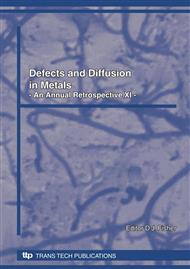[1]
M.K. Miller, P.A. Beaven and G.D.W. Smith: Metallurgical Transactions A, 1981, 12A, 1197.
Google Scholar
[2]
L. Chang, S.J. Barnard and G.D.W. Smith: Fundamentals of Aging and Tempering in Bainitic and Martensitic Steel Products, ISS-AIME, Warrendale, PA, (1992), p.19.
Google Scholar
[3]
J. Wilde, A. Cerezo and G.D.W. Smith: Scripta Materialia, 2000, 43, 39.
Google Scholar
[4]
J.A. Yan, C.Y. Wang, W.H. Duan and S.Y. Wang: Physical Review B, 2004, 69, 214110.
Google Scholar
[5]
Y. Niu, S.Y. Wang, D.L. Zhao and C.Y. Wang: Journal of Physics - Condensed Matter, 2001, 13, 4267.
Google Scholar
[6]
S. Simonetti, M.E. Pronsato, G. Brizuela and A. Juan: Applied Surface Science, 2003, 217, 56.
Google Scholar
[7]
K. Tapasa, Yu.N. Osetsky and D.J. Bacon: Acta Materialia, 2007, 55, 93.
Google Scholar
[8]
J.P. Hirth and J. Lothe: Theory of Dislocations (McGraw-Hill, New York, 1968).
Google Scholar
[9]
M. Wen, S. Fukuyama and K. Yokogawa: Acta Materialia, 2003, 51, 1767.
Google Scholar
[10]
Yu.N. Gornostyrev, M.I. Katsnelson, A.Y. Stroev and A.V. Trefilov: Physical Review B, 2005, 71, 094105.
Google Scholar
[11]
N.I. Medvedeva, Yu.N. Gornostyrev and A.J. Freeman: Physical Review Letters, 2005, 94, 136402.
Google Scholar
[12]
N.I. Medvedeva, Yu.N. Gornostyrev and A.J. Freeman: Physical Review B, 2005, 72, 134107.
Google Scholar
[13]
L.Q. Chen, Z.C. Qiu, C.Y. Wang and T. Yu: Journal of Alloys and Compounds, 2007, 428, 49.
Google Scholar
[14]
L.Q. Chen and Z.C. Qiu: Defect and Diffusion Forum, 2007, 261-262, 37.
Google Scholar
[15]
B. Delley: Journal of Chemical Physics, 1990, 92, 508.
Google Scholar
[16]
B. Delley: Journal of Chemical Physics, 1991, 94, 7245.
Google Scholar
[17]
D.E. Ellis and G.S. Painter: Physical Review B, 1970, 2, 2887.
Google Scholar
[18]
D. Guenzburger and D.E. Ellis: Physical Review B, 1992, 45, 285.
Google Scholar
[19]
L.Q. Chen, C.Y. Wang and T. Yu: Journal of Applied Physics, 2006, 100, 023715.
Google Scholar
[20]
L.Q. Chen, C.Y. Wang and T. Yu: Chinese Physics B, 2008, 17, 0662.
Google Scholar
[21]
S.H. Vosko, L. Wilk and M. Nusair: Canadian Journal of Physics, 1980, 58, 1200.
Google Scholar
[22]
C.Y. Wang, S.Y. Liu and L.G. Han: Physical Review B, 1990, 41, 1359.
Google Scholar
[23]
C.Y. Wang and D.L. Zhao: Materials Research Society Symposium Proceedings, 1994, 318, 571.
Google Scholar
[24]
C.Y. Wang: Defect and Diffusion Forum, 1995, 125-126, 79.
Google Scholar
[25]
R.S. Mulliken: Journal of Chemical Physics, 1955, 23, 1833.
Google Scholar


